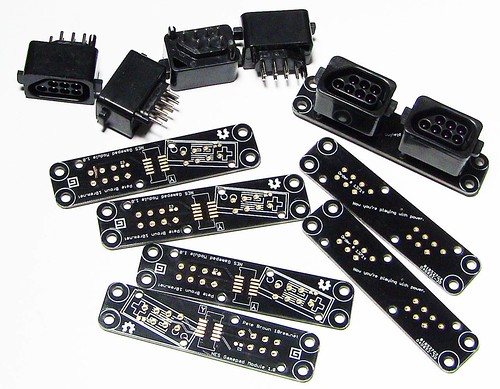And you say you work for a software company?

Those boards look really nice. I use Eagle since it ought to be the most widely spread but that 3D renderer looks nice so maybe I should change...
Regarding 3D models of various chips, I can imagine that standard parts are readily available in DipTrace and that many models (made by others) are often shared and made available for download from somewhere. Correct?
How often do you find yourself having to create new models yourself and how long does it take you to model, say a QFN64?
Also, Is it possible to import schematics and boards from Eagle into DipTrace?
>>Software company
You should see the cool electronics lab in the MS Research building. They have multiple SMD soldering workstations with microscopes, a large CNC mill and lathe, a 3d printer, a laser cutter, a CNC mill for PCBs, and lots LOTS more. It's like a rich person set up a hackerspace. It's almost enough to make me want to move up there to use it 
Here are a few photos:
It was Chris and Netduino which got me into electronics just a couple years ago. I'm still painfully ignorant of most analog electronics (which I'm working to fix), but digital stuff, once you get the support components down, is just like code 
>>Those boards look really nice. I use Eagle since it ought to be the most widely spread but that 3D renderer looks nice so maybe I should change...
I've used a number of packages. The first one I used was DesignSpark PCB. This is a good package, but was missing a lot. I tried several others after that, not creating anything real. Then I used Eagle. Eagle is great, but the way they enforce the PCB size was constantly in my way. I couldn't move stuff out of the way to lay things out because Eagle would complain it was outside the allowed area. Also, the UI for Eagle was obviously created by someone who has never used any other program on their PC. The "select a tool and then click the item" is backwards from any other desktop app, and drove me crazy. The worst was copy/paste.
I also found that in EAGLE it was really easy for me to *think* I wired up a pin on the schematic only to find out it wasn't actually connected. That happened a lot. It was likely some quirk of how I use it, but it was annoying.
DipTrace is the first package I've bought. They license by pin count, without (as I recall) any restrictions on board size. The UI works a lot like any other PC program. My only gripe so far is how they navigate around library components in both the PCB and the Schematic editors. That's one part I find cumbersome. Also, you won't be able to use the design rules files or scripts from EAGLE. Luckily, the built-in rules already cover the typical hobby PCB settings, and creating the gerbers is really easy, not requiring a script.
>>How often do you find yourself having to create new models yourself and how long does it take you to model, say a QFN64?
I haven't created any 3d models. The models are by package, so most chips and discretes are covered on the footprint/pattern side as well as the 3d model side.
I have created a number of components for the schematic and PCB. The part I hate about doing that is the footprint/pattern part. However, it's much easier in DipTrace *and* they have a huge library of existing patterns you can just use.
So, for example, I had to create an STM8S component, but the pattern and the 3d model were already there. I just had to name pins and lay them out for the schematic. With the data sheet open, that took like 10 minutes or so.
I've also created components from scratch. For example, the Cherry MX switch pattern and component I created. This was really easy to do once I had the dimensions from Cherry.
>>Also, Is it possible to import schematics and boards from Eagle into DipTrace?
I haven't tried importing schematics from Eagle. However, my MIDI connector and the NES connector used here are both patterns and component I originally created in Eagle and then imported. You'll need Eagle on your machine (the free one) because you have to export the library in Eagle first.
DipTrace does a much better job with graphics and TrueType fonts, automatically exporting both as vectors when you create the gerbers.
DF Robot sent me a message last night saying my PCBs for the MIDI/DIN x3 and MIDI/DIN x6 both checked out without errors. I verified them in gerbv before sending anyway (although DipTrace has a nice built-in Gerber preview) so I wasn't expecting problems. It's nice to have the validation, though.
Pete


















